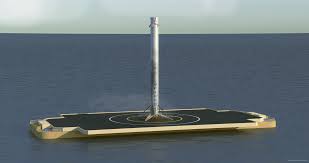I have been a fan of science fiction since I was a kid. Books, magazines, movies, television shows, comics, etc. were a refuge from the daily grind. When rocket ships were part of the story, they were usually shown as tall and thin. When they took off and landed, they went straight up or straight down, landing on their tail. These fictional spaceships were single vehicles that were entirely self contained.
When the space age actually arrived, the big rockets needed boosters that helped lift the vehicles out of the Earth's atmosphere but then broke away from the orbital vehicles and fell back to Earth, usually over an ocean. This was usually safe but ultimately wasteful, raising the cost of transporting men and supplies to orbit. NASA developed a system that would allow them to bring boosters down with parachutes to land in the ocean. Then they would fish out the boosters, get them back to dry land and refurbish them. This was a time consuming and costly process. One of the big current goals for space flight is to find a way to recover launch vehicles by having them come down vertically on land, radically reducing the cost of recovery and making refurbishing cheaper.
I have blogged about SpaceX, a commercial company that can launch supplies into orbit. They have passed a competition held by NASA to launch supplies to the International Space Station along with the Boeing company. The company has successfully launched supply packages to the ISS. Recently, SpaceX has begun working on a way to recover their first stage boosters by having them land back at the launch site.
Last week, SpaceX launched a package of supplies in a Dragon cargo ship to the ISS with one of their Falcon 9 launch vehicles. Part of that mission was to test a soft vertical landing for the first stage booster. The plan was to haul a barge two hundred miles out into open ocean off Florida and land the booster gently on the barge. The booster was equipped with four landing legs and four fins to guide it to the landing place. The launch was successful and the Dragon cargo ship was delivered to orbit.
The booster managed to make it to the vicinity of the barge but was descending too fast and crashed into the barge, breaking into pieces. The guidance fins functioned properly as the craft decelerated from hypersonic to subsonic velocity. However, the hydraulic fluid that powered the fins ran out right before the landing attempt on the barge.
The next launch of a Falcon 9 will include fifty percent more hydraulic fluid to supply the steering fins. The first test landing may have failed but it almost succeeded. Hopefully the next test will actual succeed in landing a spent booster softly in a vertical descent. When the process has been thoroughly tested over open water, the next phase of testing will have the boosters landing on dry land at the launch site. The old fictional vision of spacecraft taking off vertically and landing vertically will finally be real.
Artist's rendering of soft landing of SpaceX Falcon 9 first stage booster:
